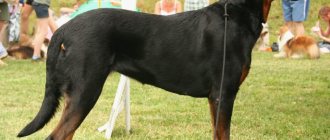Criteria for a dog's lifespan
The life expectancy of a St. Bernard at home is not as long as if the dog lives in an enclosure or leads an active lifestyle. Initially, the breed was bred as a rescuer who searches for people in the mountains during avalanches and landslides. Keeping him in a cramped apartment is not good for an overweight, large dog. Walking on rough terrain is beneficial for your pet. It is worth paying a lot of attention to the content of the St. Bernard.
Hereditary predisposition plays an important role in a dog's lifespan. Whether your pet's ancestors were long-lived, what diseases they suffered from - the future life of the puppy depends on all this.
Males live longer than females; bearing offspring and giving birth exposes the animal to additional risk and affects its health. The more litters a bitch has, the more her lifespan is reduced. Sterilization can solve the problem. It also helps male dogs, preventing the development of reproductive diseases.
St. Bernard's character
If you have a St. Bernard, be prepared for the fact that this giant will be cramped in the apartment, which will make the dog less emotional. On the street, an adult animal will explore the world with interest. The character of the St. Bernard is phlegmatic by nature, and while puppies sparkle with emotions, adult dogs are distinguished by sedateness and importance.
Despite this, animals need to be surrounded by people who give them love, affection, understanding and tenderness; They are close to enthusiasm, they love to play outside in winter, having fun wallowing in the snow. The character of St. Bernards is characterized by the appearance of a rare melancholy, passive rather than active rest and, despite this, interest in everything that happens nearby.
Who is a St. Bernard dog suitable for? For a family person, because at home, alone with the owner, they behave more relaxed. Dogs of this breed can become a loyal friend to their owner, a caring nanny (children are not at all a burden to these giants), and first-class house watchmen. Other animals do not disturb the dog at all, nor do strangers. But at the same time, the giant can become a reliable guard if necessary.
Find the answer
Training and physical activity are the key to the longevity of any dog. At home, the St. Bernard will be bored, he will begin to experience problems with the circulatory system, joints, and muscles. The development of depression is also possible. Regular exercise and plenty of walks help keep your pet's weight at a healthy level. It is better to walk outside the city or in the park, getting rid of the leash or harness.
Medical care should include vaccinations, but also regular medical examinations. In the first 5 years, the puppy is taken to the veterinarian at least once a year, and after that - 2 times a year. It is important to carry out deworming, protection against ticks and fleas. The coat of this breed is thick and is brushed weekly.
Cost of St. Bernard puppies
St. Bernard puppies are common. You can buy a dog without documents “from your own hands” for only 4,000-8,000 thousand rubles, although in this case the owner will not have a guarantee that the pet is healthy, and after a couple of months a number of health problems may “surface”.
A puppy suitable for further breeding, with a good pedigree, can be purchased for 25,000-30,000 thousand rubles. And the future champion will cost no less than 45,000 thousand rubles.
Before purchasing, you need to decide for what purpose you are purchasing the puppy. With proper upbringing, a little St. Bernard can become a devoted friend and a true companion. But you should take into account its dimensions and features of content; the giant is not suitable for everyone. If the owner does not have a place where he can comfortably place a large pet, he should refuse the purchase so as not to create additional difficulties and discomfort for the dog.
Nutrition
St. Bernard can be fed at home with food or natural products. Cooking food from natural products takes more time and effort. So that the dog’s diet is compiled correctly. At least a third of all food should be pure protein. Meat, offal, yogurt, kefir, and cottage cheese are used. Fermented milk is allowed - whole milk is not allowed. Lactose intolerance is not uncommon among representatives of the breed.
Ready-made food should belong to the premium or holistic classes. They contain essential proteins, microelements, and vitamins. It is important to supplement natural nutrition with vitamins for dogs; they can be added directly to porridges and soups for dogs. Normally, an adult St. Bernard reaches the weight of an adult - up to 70 kg or more.
Diet
St. Bernards do not need to be fed in buckets. A healthy stomach of an adult dog does not exceed two liters in volume. The food should be highly nutritious: meat rations or good dry food. The natural diet includes porridge, meat and fish dishes, and vegetables. It is important to maintain portion sizes and not overfeed dogs, as they have a predisposition to obesity and diseases of the digestive system. If you don't know how to prepare food for dogs or don't want to do it, buy dry food. It is better to pay attention to higher premium food and diets for large and giant breeds. As for the quantity, it is calculated by weight. For example, a dog weighing 80 - 90 kg should eat less than 1 kg of dry food per day.
Particular attention should be paid to nutrition during the period of active growth of the puppy, when the musculoskeletal system and its own immunity are intensively formed.
Feeding rates:
- Small St. Bernard puppies are fed 6 times a day. At this age, puppies need cottage cheese and milk. Subsequently, it is better to replace them with fermented milk products.
- Three month old puppies are fed 4 times a day.
- Upon reaching the age of 5 months, dogs are transferred to three meals a day.
- A St. Bernard who has reached the age of 7 months is transferred to an adult diet, two meals a day.
Breed diseases
Owners of St. Bernard dogs rarely complain about weak immunity and diseases of the pet.
The breed is characterized by diseases:
- Gastrointestinal diseases, bloating, stomach problems - due to poor nutrition.
- Joint dysplasia - hip or elbow.
- Injuries - dislocations, ligament ruptures.
- Deafness is congenital in Saint Bernards.
- Cardiomyopathy and other diseases of the cardiovascular system.
- Eye diseases - inversion and inversion of the eyelid, cataract.
- Oncological diseases - most often lymphoma or osteosarcoma.
On average, a St. Bernard can live no more than 10 years, but usually the life expectancy of this pet is even shorter. If you want to spend at least this period of time with your dog, you need to take good care of him.
Health and disease of St. Bernard
Possible diseases
From birth, St. Bernards have excellent health, but over time, like people, they age, and diseases caused by heredity “come out” to the surface. They may have congenital problems with their ears (sometimes puppies are born deaf), paws, and eyes. Usually problems arise with the musculoskeletal system, the functioning of the digestive organs and endocrine system, and eye health. They chase animals throughout their lives.
The most common diseases in St. Bernards are:
- dysplasia (dislocation) of the elbow and hip joints;
- ligament ruptures;
- herniated discs;
- epileptic seizures;
- lymphoma;
- bone or blood cancer;
- eversion and inversion of the eyelids;
- cataract;
- metabolic disease;
- bloating;
- obesity;
- allergies (immune system reaction to food, viruses, insects, poor-quality vaccinations).
What should you do to get your pet to hold its tail like a gun? To prevent illnesses, it is advised to monitor the dog’s diet, do a “morning toilet” (comb the fur, wipe the eyes, face, nose, clean the ears); In addition, you need to monitor the condition of the St. Bernard's teeth and his sexual health.
Reproductive health
If the owner chooses not to breed the bitch, it is better to sterilize it (in this case the question will arise “what to feed a sterilized animal”). Often, breeders think about the offspring of their pet quite late, while the first mating of a female dog should occur no earlier than her second heat (the first comes at the age of 8-9 months) and no later than four years. If these conditions are not met, the animal’s health will be at risk: difficult pregnancy and childbirth, complications, the cost of treatment of which is high.
Factors influencing lifespan
The life expectancy of dogs is influenced by factors:
- Physical development;
- Does the animal perform loads appropriate for its age and breed;
- Complete rest;
- A balanced diet enriched with nutrients;
- Sufficient communication and attention.
All these quality indicators of life depend 100% on the owner. The way he takes care of his pet shapes the animal’s resistance to stress and various diseases.
A balanced diet from birth lays the foundation for the pet’s physical health for the rest of its life and even into old age. An older dog should be fed soft food to avoid problems with teeth and swallowing.
In old age, animals can suffer from various diseases, most often deteriorating hearing, vision, and disruptions in the urinary system.
Another problem that can significantly reduce the age of any animal is excess weight. Its excess has a bad effect on the pet’s health, affecting the cardiovascular system and bone structure. It is necessary to control the weight of the animal, especially in old age.
Regular medical examinations, vaccinations, timely contacting a veterinary clinic in case of problems - this is what will keep your pet in the right shape. Constantly caring for your pet throughout its life can significantly increase its cycle.
How to choose a strong and healthy St. Bernard puppy
The day has come to go to the nursery for a cute puppy. Babies should be kept in a clean enclosure, without a specific unpleasant odor, which is very important. First of all, the breeder will demonstrate the numerous awards that his pets have received. Listen carefully, but don’t be easily fooled by all the big titles and championship accolades. If possible, you need to look at the parents of the future pet. The main 10 signs that will help you choose a healthy St. Bernard puppy:
- shiny and moist nose;
- clean ears, pink;
- lively, clear look;
- clean eyes, without any discharge;
- full number of teeth and correct bite;
- healthy skin, without parasites, sores and acne;
- silky, shiny coat;
- lymph nodes of normal size;
- the tail is without creases or docked;
- no bloating.
A good proof that the animal is healthy is a written document of purchase and sale. If the St. Bernard puppy develops abnormalities over time, according to the contract, the pet can be returned. Having “insurance” with the buyer will reduce the risk that the seller will slip in a problem animal.
How long do purebred animals live?
According to veterinary experts, there is a clear relationship between the breed and the years measured to the animal. It has been scientifically proven that the smaller the dog, the longer its life.
The vitality of representatives of different breeds varies. This is due to human breeding activities. When developing standards, dogs develop and reinforce features that are often unnatural.
Breeding a breed is fraught with complications, which are expressed in hereditary diseases:
- Chihuahua. These cute little creatures are genetically prone to medial dislocations of the kneecaps, elbow joints, and various dysplasias.
- Dachshund. Natural hunters, with a funny long body on short legs, pay with health for such a body structure. Hereditary pathology in dachshunds is intervertebral disc disease.
- Shar-Pei. Not only in this breed of dog, but in all pets with skin folds, the disease entropion, which is essentially an entropion of the eyelid, is common.
- Rottweilers. Strong, brave, fearless, smart. But they are also susceptible to hereditary diseases - aortic stenosis, Rottweiler leukoencephalopathy, follicular lipidosis.
- Pikines. This ancient breed is distinguished by a special eye structure, for which it suffers from a tendency to eversion of the eyelids, cataracts, and corneal ulcers.
Advantages and disadvantages
To summarize all of the above, this breed has a number of advantages:
- The size of the dog commands respect from everyone in the area;
- Saint Bernard is a balanced, intelligent and kind animal;
- Unpretentious in nutrition;
- Voices only in the most extreme cases;
- Can play the role of a guard dog, relying mainly on its size;
- If you really want, you can knit warm clothes from a dog’s faded fur,
A sweet couple
and a number of disadvantages:
- It is difficult for a large animal to live in a small apartment;
- Keeping a St. Bernard is not a cheap pleasure;
- On a walk, the child will not be able to hold the male dog if he runs after the “lady of his heart”;
- St. Bernards shed heavily, including the short-haired breed;
- Some St. Bernards like to chew boots and bark when they are puppies;
- Active salivation.
Long-lived dogs
Despite statistics and calculations, nature never ceases to amaze; the Guinness Book of Records confirms this. On its pages there is data about long-lived dogs that have outlived their required age by more than 2 times:
- The first record-breaking pet was the Austrian shepherd, whose lifespan was more than 29 years. All his life the dog guarded sheep flocks and was active until his last days.
- Terrier Max is approaching his 30th birthday. The dog never received any care and ate regular food.
The length of a dog's life is individual, but the owner of the dog can make it long enough, happy, colorful!
Among some breeds there are real long-lived dogs. All other things being equal, a border collie, for example, will live longer than, say, a boxer or a great dane.
The Dachshund is the most famous, friendly hunting breed. The dachshund, despite its appearance, is a courageous, courageous, serious, purposeful, and independent dog. These funny little guys live up to 17 years on average, but sometimes reach the 20-year mark.
The main “danger zone” is a long spine, problems with intervertebral discs are possible; tend to be overweight, more often when they begin to age. These problems can be prevented by balanced exercise and a healthy diet.
Yorkshire Terrier: representatives of this, at first glance, small and weak decorative breed live on average 14-16 years, which is longer than huskies. The Yorkshire Terrier weighs 2-3 kilograms, but it is not fragile - they were previously used to exterminate rats.
This fact does not prevent their owners from decorating their pets with various bows and ribbons. The diseases to which Yorkies are susceptible are caused by “smallness.” This list includes non-overgrowth of the fontanel, cryptorchidism, Perthes disease, distichiasis.
An active and smart Beagle will not let its owner get bored. These cheerful and noisy pets live an average of 15 years. They have a good appetite, especially in adolescence (they eat whenever they see food), so they do not need to be overfed.
Obesity will not benefit the Beagle. Epilepsy is relatively common, but it can be successfully treated. Typical diseases of beagles are boils, glaucoma, and cataracts. Due to the long, flexible ears, the inner cavity does not receive sufficient ventilation, which will lead to infections.
Saint Bernard is a charming giant with a peace-loving character and a slightly sad look. It is considered a typical family dog, but with the right training course it can become an excellent rescuer or watchman. Calm, disciplined, sincerely loves children.
Basic moments
- Balanced and good-natured by nature, St. Bernards easily get along with any pets, from cats to feathered pets.
- Rescue dogs love companionship, but also cope well with temporary loneliness, unless it becomes permanent.
- A characteristic feature of St. Bernards is intense salivation, so if you are not ready to wipe liquid “traces” from the floor, furniture and laps of your household, take a closer look at other breeds.
- Adults are moderately playful and love long walks. But intense cardio exercises only harm representatives of this breed.
- The dogs are calm, do not make unnecessary noise and bark only in exceptional cases.
- Saint Bernards tolerate moderately low temperatures well and suffer greatly from heat. During the summer months, the animal will need a specially equipped shelter or corner in which it can cool down a little.
- They are well oriented in space and easily find their way home, even if they find themselves in an unfamiliar area.
- Saint Bernards are quite loving and equally affectionate towards every member of the family.
Saint Bernards are natives of the Swiss Alps, selfless rescuers of travelers lost in the mountains, known for their phenomenal devotion to people. Serious and collected, these white-red giants are completely devoid of arrogance and the desire to “show off” in front of their relatives. And what’s the point of proving something to someone with such impressive dimensions. Saint Bernards feel most comfortable in large, friendly families, where they are certainly not threatened by loneliness and lack of communication.
Breed characteristics and character
Most people get scared when meeting an animal; even in a photo, the St. Bernard looks impressive. However, you should not be afraid of St. Bernards, because this breed of dog is distinguished by high moral qualities and intelligence.
Despite their enormous size, the hay takes up little space. Usually a small piece of territory is enough for them, but due to their love of love and some indifference, dogs are located right in the middle of the aisle or in the path of a person’s movement.
Adult St. Bernard on a walk in the forest
The character of the St. Bernard is melancholic; adults prefer a quiet pastime, unlike frisky puppies. During walks, the hay comes to life: most of all, dogs enjoy slow walks in nature, especially in previously unknown places.
The Saint Bernard breed is extremely sociable, gets along well with children, playing the role of a good nanny. Dogs are easy to train and educate, and conscientiously follow orders. There are many stories of St. Bernards saving lives.
This breed is a true friend of man, distinguished by devotion and love for the owner. Sens tolerate loneliness terribly and, without communication, often become bored or depressed, and a closed space or a chain for dogs is akin to betrayal - the animals become nervous and aggressive.
Saint Bernards are often used in search and rescue work; in France there is even a monument to the dog who saved 40 people
History of the Saint Bernard breed
The history of the formation of the breed goes back so far that experts can only speculate as to who actually was the ancestor of rescue dogs. Most modern researchers are inclined to believe that the ancestors of today's St. Bernards were Tibetan Great Danes - massively built dogs that settled throughout Central and Asia Minor in the 4th century BC. e. The animals came to Europe with the convoys of Alexander the Great, who brought them as war trophies, first to Greece, and then to Ancient Rome. However, some scientists continue to consider St. Bernards to be the “product” of mating a Great Dane with a Mastiff.
Historical reference
In the 11th century, on the Great St. Bernard Pass, in the Swiss Alps at an altitude of 2469 meters, the monks organized a shelter for travelers, wanderers and pilgrims at the monastery.
From the middle of the 17th century, large mountain dogs began to guard the peace of the monastery refuge. The first documentary mention of these dogs and their image dates back to 1695 , and in 1707 written records appeared in the documents of the monastery.
Dogs are beginning to be used to accompany and rescue travelers lost in snow and fog.
Publications appear in different countries telling about numerous cases of St. Bernards saving people from “white” death. Along with this, the stories of soldiers who participated in Napoleon Bonaparte’s conquest campaigns and who in 1800 made crossings of the mountains with the help of St. Bernards, then called “Barry’s dogs,” are passed on from mouth to mouth.
This further strengthens the fame of St. Bernards, which spread throughout Europe in the 19th century. And the legendary Barry became the prototype of a rescue dog.
The direct ancestors of the St. Bernards are considered to be large farm dogs that lived in those regions. After several generations, through systematic crossbreeding in order to improve certain qualities, the St. Bernard breed in its present form was obtained.
In 1867, Heinrich Schumacher from the town of Holligen near the city of Bern began keeping the first stud book of his dogs. In 1884 the Swiss Stud Book (SHSB) was published. Number one was a St. Bernard named "Leon" , and the next 28 entries also concern St. Bernards.
On March 15, 1884, the Swiss St. Bernard Club was founded in Basel.
On June 2, 1887, the Saint Bernard was officially recognized as a Swiss breed , and the breed standard was declared mandatory.
Since that time, the Saint Bernard has been considered the national Swiss breed.
Description of the breed
Standard of the International Cynological Federation FCI No. 61 dated October 29, 2003 “St. Bernard." Group 2 “Pinchers and Schnauzers, Molossians, Mountain and Swiss Cattle Dogs.” Section 2 “Molossians”.
Limitations on height at the withers: 70-90 cm for a male, 65-80 cm for a female. Dogs whose height exceeds the maximum are not punished if the excess does not violate the proportions of the structure and the correctness of movements.
There is no official weight limit.
A description of the St. Bernard's appearance according to the official standard is given in the table.
| HEAD | Powerful, impressive and very expressive. |
| EYES | Medium size, dark brown to nut color. Set moderately deep, the expression of the eyes is friendly and welcoming. |
| EARS | Medium size, set high and wide, with highly developed cartilage, soft, triangular in shape with rounded ends. The front edge of the ears fits close to the cheekbones, while the back edge is slightly raised. |
| TEETH | The jaws are strong, wide, and equal in length. The bite is complete, regular, well developed: scissor or pincer-shaped. |
| NECK | Strong and of sufficient length. |
| BREAST | Moderately deep, with well sprung ribs, but not barrel-shaped. Should not fall below elbow level. |
| PAWS | Wide, with strong, dense, well arched toes. Dewclaws are allowed provided they do not interfere with the dog's movement. |
| TAIL | At the base it is wide and thick, long, heavy. In a calm state, the tail is lowered down or may curl slightly upward in the last third; in an alert state, it is raised higher. |
| WOOL | There are two types: short-haired and long-haired. |
| COLOR | The main coat is white with larger or smaller reddish-brown markings (coat with small spots). On the back and sides, the presence of a solid or “torn” reddish-brown “cloak” is welcome, and on the head – the presence of a dark color. We accept red color with brindle and brownish-yellow colors. Small patches of black on the dog's body are not considered a defect. |
Breed standard
To win at international exhibitions, the St. Bernard (photo below) must meet the requirements established by the standard, which lists the ideal characteristics of the winner :
- large muscular body , large, picturesque head, sad, slightly wary eyes;
- mandatory correspondence of the proportions of individual parts of the body relative to each other;
- the skin of the forehead hangs slightly in folds over the eyebrows, a black nose with wide nostrils;
- Deep-set eye color ranges from hazel to dark brown;
- hanging, widely spaced ears;
- powerful long neck;
- straight horizontal back, toned stomach;
- hanging down, slightly curved tail with thick hair;
- straight forelimbs and slightly elongated hind limbs, supported by wide, strong paws.
There are two types of St. Bernard breed : short-haired and long-haired.
A short-haired dog has a body covered with thick, even, low hair with a dense undercoat. The long-haired dog is covered in shiny, medium-length fur that curls slightly on the sides and back. The covering is of medium hardness, with warm, soft fur closer to the body. The neck is covered by a beautiful white collar due to longer and curly hair.
Spotted Saint Bernards have a white color, along which spots of red-red shades of varying sizes are scattered.
Raincoat dogs have a solid red color along the spine and sides - a raincoat.
The chest, paws, tip of the tail, area around the nose, stripe on the forehead, spot on the nape of purebred St. Bernards are snow-white . A white cape on the neck and a kind of dark-colored mask on the muzzle are welcome.
The Swiss dog breed is famous for its impressive weight of about 80 kg. Representatives of different sexes differ in size: males grow up to 70–90 cm, their female friends are slightly lower – up to 65–85 cm .
A purebred dog has:
- strong skeleton
- large proportional head,
- shiny thick fur,
- clean organs of sight and hearing,
- contrasting color,
- with a stable and confident gait,
- properly formed teeth.
While outwardly phlegmatic and complacent, dogs move actively and energetically in open, free territory. Their movements are harmonious and precise. Full of energy, the St. Bernard can run a long distance without fatigue.
Beauty and precision are present in every movement of a running dog: he stands up, straightens his limbs, steps gracefully, pushes off the ground with powerful hind legs and begins to run with an elongated, straight back.
Not all Saint Bernards meet the high requirements of the standard. On average, one dog produces from 1 to 12 puppies in a litter. Of these, only 2–3 correspond to exhibition standards.
The disadvantages of the breed include:
- disproportionate parts of the body;
- limbs that are twisted or short compared to the rest of the body;
- head that does not meet the standard;
- light eyes;
- uneven back;
- tail raised up;
- curly hair;
Negative qualities for which dogs may be disqualified at shows :
- malice;
- timidity;
- malocclusion;
- solid color of a single color.
Characteristics, abilities, skills
By nature, St. Bernards are welcoming, friendly, and alert – they are among the ten kindest breeds in the world. Temperament from calm to active.
The Saint Bernard has an excellent natural sense of smell, as well as innate vigilance and attentiveness. The characteristics of the breed include goodwill and a sad, understanding look. Agility and pranks are characteristic of St. Bernards only in puppyhood - as they grow older, these dogs become more obedient.
At first glance, it may seem that St. Bernards are lazy and slow, but once you start training them, the dog will show itself in all its glory. The talent for spatial orientation has also been preserved.
Saint Bernard is strongly attached to his family, avoiding conflicts in every possible way thanks to his innate wisdom. He loves children very much, even allowing them to sit on horseback. But he doesn’t like to be alone, feeling the need for communication.
In the process of education and training, it is necessary to show patience and respect. Using force and rudeness against a St. Bernard is unacceptable. The breed is characterized by increased discipline and respect for its owner, and it will happily follow all commands provided that it is addressed respectfully and affectionately.
You cannot keep a dog on a chain or in an enclosure, infringing on its freedom and dignity.
Character
The distinctive character traits of the St. Bernard include:
- cheerfulness;
- friendliness;
- attachment to the owner;
- easy contact;
- thoughtfulness;
- calm;
- lack of aggression.
Attitude towards people and especially children
The Saint Bernard is ready to devote his entire life to his family. The pet fulfills all the requirements of its owner. The dog does not need constant attention. However, if the dog notices that children are playing without him, he will immediately find himself in the center of the game. Saint Bernard easily makes contact with children. He is ready to participate in all the intrigues of children. A pet can also be an excellent nanny for a child.
Intelligence
For some, the large size and sad expression on the face of St. Bernards is proof of the animal’s lack of intelligence. This opinion is wrong. Representatives of the breed are well oriented in the area, thanks to which they can find and save people.
Saint Bernards always want to please their owner, so there are no problems in the process of raising pets. The dog will happily follow all commands. If you add praise and treats to typical training, the process will speed up.
Activity
An adult St. Bernard requires active walks. You need to take your pet out twice a day. The total walking time should be about 4 hours. While walking, you can train your dog or play ball with it, throw a stick and use other entertainment for an active pastime.
Security and guard potential
In the past, St. Bernards not only participated in rescue operations, but also lived in the valleys as guards. Guard qualities are inherent in the pet at the genetic level.
In ordinary life, a pet will not show aggression towards strangers. However, in case of urgent need, the St. Bernard will protect his family. He can enter into an unequal fight and win.
Care and maintenance
Due to its size (it is one of the largest dogs in the world), the St. Bernard requires a large living space, so it is best to bring this breed into a private home. The dog's coat is very warm, it allows its owner to live outside and calmly endure frost and bad weather.
For the same reason, in summer it is necessary to protect the dog from the scorching sun and heat. You can bring such a dog into a large apartment if you can provide him with fresh air and regular walks.
Caring for and maintaining a St. Bernard requires regular attention from the owner. Pets with long hair should be brushed every day, and those with short hair – 2 times a week. Bathing with special shampoos and conditioners is necessary when soiled.
An adult dog will not fit in a standard bathtub, so you should think about a place for water procedures.
Shedding is infrequent: 2 times a year. During this time, brush your pet more often.
You should regularly wipe your dog's eyes and mouth due to increased salivation and the appearance of smudges.
To participate in exhibitions, your dog will need to have a professional haircut. A hygienic haircut at home is also suitable for everyday life.
How long do St. Bernards live? Unfortunately, it doesn’t last long - from 8 to 10 years, and this is their main, and perhaps the only drawback...
What to feed a St. Bernard? The puppy's diet should contain a number of vitamins that maintain calcium levels in the body. Food should be natural and fresh. In the sample menu, include about 200 grams of meat, cottage cheese, vegetables, porridge, boiled eggs and sea fish are acceptable, as well as constant fresh water.
The amount of food needed increases as the pet gets older. The main products should be those that contain protein: raw meat, boiled offal, steamed sea fish, various seafood products. Dry food is acceptable at least premium and super-premium class.
Don't forget to give your adult dog bones and cartilage to strengthen his teeth.
How much does a Saint Bernard cost?
The price of a St. Bernard depends on the “purpose” of the animal and the urgency of the sale. Kennels usually sell three categories of puppies:
- Pet class
. The average price of a puppy not allowed for breeding due to the presence of serious defects in the exterior varies from 5,000 to 20,000 rubles. The seller is obliged to notify buyers of the severity of the defect. - Middle, or breed class
. A Saint Bernard with a minor defect will cost the buyer an average of 25,000 rubles. Such dogs participate in exhibitions and often take prizes. - Show class
. A dog of this level costs more than 30,000 rubles because it has a good gene pool; Breeders often leave such puppies in the kennel, because they will often take first places at shows.
A faithful friend, a reliable protector, a melancholic rescuer - all this is about the St. Bernard. Happiness and comfort will always reign in the house where he lives.











